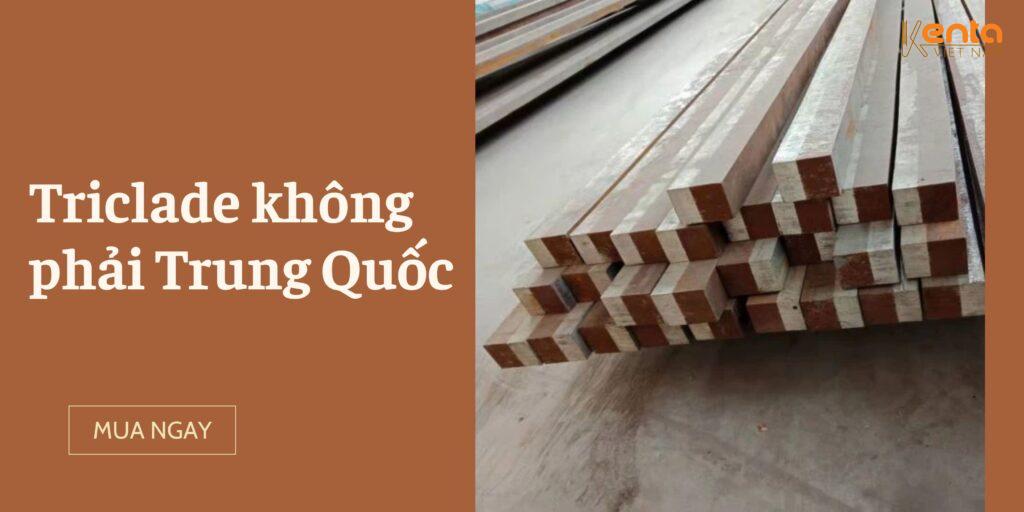Knowledge, Technology
Triclade is not from China — Origin, Quality, and Applications
Triclade not from China is an important assertion before deciding to choose clad material for a marine project. In a market with diverse supply sources, distinguishing the origin of products helps investors and contractors avoid technical risks. This article provides an in-depth analysis of Triclade not from China, from the scientific basis of multi-layered materials to the acceptance process, along with notes on ordering and construction, and clarifies the role of Kenta VietNam as a supplier and technical consultant in Vietnam.
Origin and quality control prove Triclade is not from China
Triclade not from China is often manufactured by factories in Europe or regions with strict production standards. These factories tightly control raw material input, the cladding process using rolling or explosive welding, and surface treatment steps. Therefore, Triclade not from China has high uniformity in mechanical properties and corrosion resistance compared to some other opaque imported products.
Technical and performance differences of Triclade
When evaluating Triclade not from China from a technical perspective, attention is paid to the alloy composition, the structure of the intermediate layer, and the bonding method. The intermediate layer plays a role in minimizing thermal stress and preventing galvanic corrosion between aluminum and steel. Microstructure analysis, phase inspection with a scanning microscope, and cyclic salt spray corrosion testing are essential scientific steps to confirm the quality of Triclade not from China.
The acceptance process for Triclade not from China must include verification of the Mill Test Certificate, tensile testing, bond strength testing, and corrosion testing under simulated seawater conditions. Classification society standards such as Lloyd’s Register, DNV, or Bureau Veritas are often used as reference points for evaluation. Having complete documentation helps shorten the acceptance time and facilitates certification registration for ports and subsequent operational services.
Non-destructive testing and sample testing of Triclade not from China
The construction of Triclade not from China requires a strict technological process. Cutting, joint preparation, and welding must comply with the manufacturer's recommendations to avoid damaging the bond layer. On-site non-destructive testing and independent sample testing before mass installation are professional practices that help reduce technical risks and ensure long-term operational experience.
Cost and lifecycle benefits
Economically, Triclade not from China often has a higher initial investment cost compared to conventional materials. However, when considering the total lifecycle cost, this material offers benefits by reducing maintenance, extending repair cycles, and reducing downtime due to repairs. These benefits are particularly evident in offshore exploration projects, offshore structures, and applications where routine maintenance causes significant disruption.
Kenta Vietnam – Supply and consulting partner
Kenta Vietnam plays an important role in the supply chain of Triclade not from Chinain the domestic market. Kenta not only distributes certified products but also provides technical consultation on alloy selection, organizes sample testing, and supports acceptance at ports. The combination of standard-compliant goods and specialized technical services helps investors minimize risks and ensure construction progress.
From a safety and risk management perspective, prioritizing Triclade not from China is a strategy for many large enterprises. Proving the origin and quality of the material makes it easier for shipowners to access international certifications and reduces the risk of disputes in case of technical incidents. Therefore, controlling documentation, independent testing, and warehouse storage cannot be underestimated. Choosing Triclade not from China is not just a matter of origin but also a commitment to quality, safety, and long-term economic efficiency. When working with a capable supplier like Kenta VietNam, customers receive comprehensive support from material selection,verify documents, to acceptance and maintenance. Investing in reliable material sources is an investment in the safety and sustainability of the project.
————
KENTA VIETNAM – QUALITY BUILDS TRUST
![]() Main office: No. 22, Phung Cong service area, Phung Cong Commune, Hung Yen province
Main office: No. 22, Phung Cong service area, Phung Cong Commune, Hung Yen province
![]() Warehouse No. 1: Ngo Yen Hamlet, Hong An Ward, Hai Phong City (at the foot of Kien Bridge)
Warehouse No. 1: Ngo Yen Hamlet, Hong An Ward, Hai Phong City (at the foot of Kien Bridge)
![]() Warehouse No. 2: No. 22, Phung Cong service area, Phung Cong Commune, Hung Yen province
Warehouse No. 2: No. 22, Phung Cong service area, Phung Cong Commune, Hung Yen province
![]() Phone: 0972 887 106 – 0961 909 992
Phone: 0972 887 106 – 0961 909 992
![]() Email: contact@kentavietnam.com
Email: contact@kentavietnam.com
![]() Website: kentavietnam.com
Website: kentavietnam.com




















